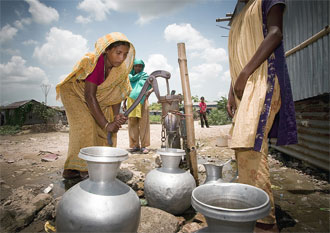 High Food Prices Spur World Food Program, Usually Employed in Rural Crises, to Find Tactics That Work in Crowded Cities
High Food Prices Spur World Food Program, Usually Employed in Rural Crises, to Find Tactics That Work in Crowded Cities
MONROVIA, Liberia — Escalating hunger in African cities is forcing aid agencies accustomed to tackling food shortages in rural areas to scramble for strategies to address the more complex hunger problems in sprawling slums.
The United Nations World Food Program, the world’s largest food-aid group, has plenty of experience trucking food into rural Africa, responding to shortages sparked by drought, famine and war. But in urban areas — where, despite widespread poverty, hunger wasn’t a significant issue until recently — the hurdles are different.
A market in Dakar, Senegal; price increases have begun to put food out of reach of the urban poor in western African cities.
In the vast and crowded slums, with many unnamed streets and dwellings without running water or electricity, it is difficult to identify who’s most in need of help. Simply handing out food can disrupt cities’ informal markets, cutting into the livelihoods of those who earn a few dollars each day selling peanuts or fresh fish, or of small farmers who haul their produce to the city.
The WFP, which usually takes the lead on aid in coordination with smaller organizations, began considering new tactics last year when it saw an urban hunger crisis developing in Africa.
Though food prices have recently declined sharply along those of a host of other commodities, and 2008 brought bumper cereal harvests in much of the world, prices in Africa on the whole remain significantly higher than they were a year ago, according to a December report by the Food and Agriculture Organization of the United Nations.
“The problem has just started here,” says Louis Imbleau, the WFP’s representative in Monrovia, the Liberian capital.
In Monrovia, home to around one million people, market stalls are stocked with fish, vegetables and rice. But Liberia, still rebuilding five years after the end of a civil war, imports more than 70% of its food and the urban poor have been increasingly strapped by rising prices.
The cost of a cup of rice has risen to nearly 50 cents from 20 cents, a huge leap for many families who live on less than $1 per day. Alice Joseph, 39 years old, who lives in a small settlement beneath an overpass in Monrovia, says she makes about $2 on a good day selling fish bought from local fishermen, and uses the income to buy rice and cooking oil to feed her husband, children and her aging mother. Often, she makes nothing; then, she says, “We drink water.”
Earlier this year, the WFP intensified its efforts to put together a program for African cities. In June, with a $500 million grant from Saudi Arabia, the aid group asked its directors in countries with high food prices, most of them in sub-Saharan Africa, to experiment with cash and voucher systems that would avoid upsetting local economies.
The WFP is working with governments and local aid groups to create programs in the West African cities of Ouagadougou, capital of Burkina Faso, and Monrovia.
“We’re learning this as we go at the moment,” says Valerie Guarnieri, director of the WFP’s program-design division in Rome.
Similar programs have been tried before, but on a smaller scale, and in rural areas. The U.N.’s division for children, Unicef, started a successful pilot program in rural Malawi in April 2006 to help what it called the “ultra-poor” — often children whose parents have died of HIV/AIDS. Sometimes the oldest child cares for the younger siblings alone. Local leaders helped to single out such families to receive a small amount of cash each month.
Read More
JOHANNESBURG, 6 January 2009 (IRIN) – Urban families in Lesotho, a small landlocked southern African country, are struggling to cope with rising food prices, according to a recent survey.





